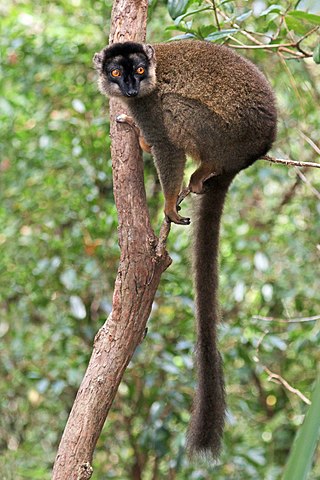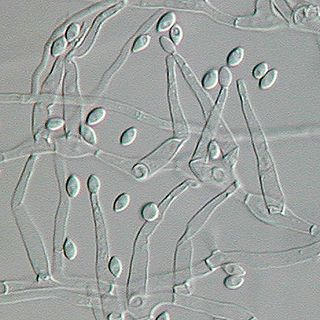
The Eurasian griffon vulture is a large Old World vulture in the bird of prey family Accipitridae. It may also be known as the Griffon vulture, though it may be used for the genus as a whole. It is not to be confused with the Rüppell's griffon vulture and Himalayan griffon vulture. It is closely related to the white-backed vulture.

The Burkholderiales are an order of Pseudomonadota. Like all Pseudomonadota, they are Gram-negative. They include several pathogenic bacteria, including species of Burkholderia, Bordetella, and Ralstonia. They also include Oxalobacter and related genera, which are unusual in using oxalic acid as their source of carbon. Other well-studied genera include Alcaligenes, Cupriavidus, Achromobacter, Comamonas, Delftia, Massilia, Duganella, Janthinobacterium, Polynucleobacter, non-pathogenic Paraburkholderia, Caballeronia, Polaromonas, Thiomonas, Collimonas, Hydrogenophaga, Sphaerotilus, Variovorax, Acidovorax, Rubrivivax and Rhodoferax, and Herbaspirillum.

The Eurotiales are an order of sac fungi, also known as the green and blue molds. It was circumscribed in 1980.
Gnaeus Arrius Antoninus was the maternal grandfather of the Emperor Antoninus Pius.

Paecilomyces is a genus of fungi. A number of species in this genus are plant pathogens.

The common brown lemur is a species of lemur in the family Lemuridae. It is found in Madagascar and has been introduced to Mayotte.

The yellow ground squirrel is a large and sturdy ground squirrel species native to Afghanistan, China, Iran, Kazakhstan, Turkmenistan, Uzbekistan and Russia. It inhabits sandy steppes with Artemisia, glasswort and tamarisk.

The fulvus roundleaf bat or fulvus leaf-nosed bat is a species of bat in the family Hipposideridae. It is found in Afghanistan, Bangladesh, China, India, Myanmar, Pakistan, and Sri Lanka.
Fulvous is a colour, sometimes described as dull orange, brownish-yellow or tawny; it can also be likened to a variation of buff, beige or butterscotch. As an adjective it is used in the names of many species of birds, and occasionally other animals, to describe their appearance. It is also used as in mycology to describe fungi with greater colour specificity, specifically the pigmentation of the surface cuticle, the broken flesh and the spores en masse.
Tampoketsa Analamaitso Reserve is a wildlife reserve of Madagascar located in the Sofia Region. It covers 17 150 ha in three districts: Port Bergé, Mandritsara and Mampikony.

Euconulus fulvus is a species of very small, air-breathing land snail, a terrestrial pulmonate gastropod mollusk in the family Euconulidae, the hive snails.
Byssochlamys is a former genus of fungi in the Trichocomaceae family, containing teleomorph forms of Paecilomyces. Several species of the genus Byssochlamys were well known to be associated with food spoilage, especially acidic heat-processed foods. A health concern was the production the mycotoxin patulin in fruit juices, as well as byssochlamic acid and mycophenolic acid.

Purpureocillium lilacinum is a species of filamentous fungus in the family Ophiocordycipitaceae. It has been isolated from a wide range of habitats, including cultivated and uncultivated soils, forests, grassland, deserts, estuarine sediments and sewage sludge, and insects. It has also been found in nematode eggs, and occasionally from females of root-knot and cyst nematodes. In addition, it has frequently been detected in the rhizosphere of many crops. The species can grow at a wide range of temperatures – from 8 to 38 °C for a few isolates, with optimal growth in the range 26 to 30 °C. It also has a wide pH tolerance and can grow on a variety of substrates. P. lilacinum has shown promising results for use as a biocontrol agent to control the growth of destructive root-knot nematodes.
Rhodotorulapepsin is an enzyme. This enzyme catalyses the following chemical reaction

Paecilomyces variotii, also known by the name Byssochlamys spectabilis for the sexual state, is a common environmental mold from the Phylum Ascomycota. It is widespread in the environment and can be found in composts, soils and wood, as well es a common environmental contaminant in indoor air and carpet dust. Ascospores of the sexual state of P. variotii are strongly heat-resistant. As such the fungus is a common contaminant of heat-treated foods and juices. Paecilomyces variotii has been associated with a number of infective diseases of humans and animals.
Isaria fumosorosea is an entomopathogenic fungus, formerly known as Paecilomyces fumosoroseus. It shows promise as a biological pesticide with an extensive host range.
Paecilomyces marquandii is a soil-borne filamentous fungus distributed throughout temperate to tropical latitudes worldwide including forest, grassland, sewage sludge and strongly metal polluted area characterized by high tolerance in heavy metals. Simultaneous toxic action of zinc and alachlor result an increase in uptake of metal in this fungus but disrupts the cell membrane. Paecilomyces marquandii is known to parasitize the mushroom, Cuphophyllus virgineus, in the family, Hygrophoraceae. Paecilomyces marquandii is categorised as a biosafety risk group 1 in Canada and is not thought to be a significant pathogen of humans or animals.
Arilla was a village of ancient Lydia, inhabited during Roman times. The village was allowed to hold an annual seven-day fair in September from the year 134-135 by Titus Aurelius Fulvus Boionius, then governor of Asia.
Paecilomyces niveus is a species of fungus in the genus Paecilomyces in the order of Eurotiales.
Paecilomyces dactylethromorphus is a species of fungus in the genus Paecilomyces in the order of Eurotiales.









